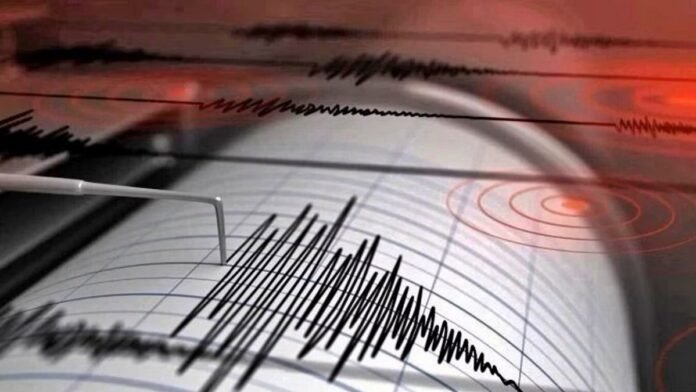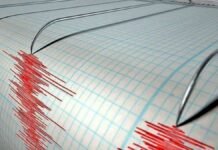
- Key Points:
A mild earthquake of magnitude 2.8 struck Ghaziabad, near Delhi, at 3:24 PM on Sunday, February 23, 2025. - The epicenter was located at a depth of 10 kilometers, according to the National Center for Seismology (NCS).
- This is the second earthquake in Delhi-NCR within a week; a stronger 4.0-magnitude quake was recorded on February 17.
- No casualties or damage have been reported, but the tremors caused panic as residents rushed out of their homes.
- Delhi-NCR remains vulnerable to earthquakes due to its location in seismic Zone IV, which is prone to moderate-to-high seismic activity.
New Delhi: Delhi-NCR experienced another earthquake on Sunday afternoon, with tremors felt in Ghaziabad and surrounding areas at approximately 3:24 PM. The quake, measuring 2.8 on the Richter scale, caused panic among residents who were mostly at home due to the weekend. People rushed outdoors with their families as a precautionary measure, gathering under open skies until the tremors subsided.
According to the National Center for Seismology (NCS), the earthquake’s epicenter was located at a depth of 10 kilometers beneath Ghaziabad. While the low intensity of the quake prevented any structural damage or injuries, it served as a reminder of Delhi-NCR’s vulnerability to seismic activity.
Second Earthquake in a Week
This marks the second earthquake in Delhi-NCR within seven days. On February 17, a stronger tremor of magnitude 4.0 jolted the region early in the morning at 5:36 AM. The epicenter of that quake was near Dhaula Kuan in Delhi, and its shallow depth of just 5 kilometers amplified its impact. Residents reported feeling buildings sway and described loud noises during the event.
The February 17 earthquake caused widespread panic as people evacuated high-rise buildings in areas like Noida, Greater Noida, and Ghaziabad. However, no casualties or significant damage were reported.
Why Do Earthquakes Occur?
Earthquakes are caused by the movement of tectonic plates beneath the Earth’s surface. The Earth’s crust is divided into large plates that constantly move due to convection currents in the mantle. When these plates collide, slide past each other, or pull apart, stress accumulates along fault lines. Once this stress exceeds the strength of rocks along these faults, it is released as seismic waves, causing an earthquake.
Delhi-NCR lies in seismic Zone IV on India’s earthquake hazard map. This zone is classified as high-risk due to its proximity to active fault lines like the Mahendragarh-Dehradun Fault and the Delhi-Haridwar Ridge. Additionally, its closeness to the Himalayas—one of the most seismically active regions globally—further increases its susceptibility to earthquakes.
Residents React
The latest tremor left many residents shaken despite its low intensity. “We felt vibrations similar to those of a passing train,” said a resident from Ghaziabad. Others described how furniture and ceiling fans shook briefly before everything returned to normal.
In contrast to last week’s early morning quake that caught people off guard while they were asleep, Sunday’s tremor saw more immediate reactions as people were awake and alert.
Preparedness and Safety Measures
Experts have long warned about Delhi’s vulnerability to earthquakes due to its dense population and ageing infrastructure. Many older buildings and unauthorized constructions in NCR lack proper seismic resistance, making them particularly susceptible to damage during stronger quakes.
To mitigate risks:
Structural Audits: Authorities must conduct audits of old buildings and retrofit them with earthquake-resistant measures.
Public Awareness: Residents should be educated about safety protocols during earthquakes, such as taking cover under sturdy furniture or standing in doorways.
Emergency Preparedness: Households should maintain emergency kits with essentials like water, food, flashlights, and first-aid supplies.
Early Warning Systems: Advanced technologies like Japan’s earthquake warning systems could provide critical seconds for people to take cover before tremors hit.
Delhi’s Seismic History
Delhi has experienced several mild-to-moderate earthquakes over recent years due to its geological positioning:
In January 2025, strong tremors from a 7.2-magnitude earthquake in China’s Xinjiang region were felt across NCR.
In May 2020, five minor quakes struck Delhi within a month, raising concerns about an impending major event.
Geologists caution that while smaller quakes release some built-up stress along fault lines, they do not eliminate the risk of larger earthquakes.
Sunday’s earthquake serves as another reminder of Delhi-NCR’s seismic vulnerability. While no damage occurred this time, experts urge residents and authorities alike to remain vigilant and prioritize preparedness measures. With increasing urbanization and population density in NCR, proactive steps are essential to minimize risks from future seismic events.
As scientists continue monitoring tectonic activity in the region, residents are advised to stay informed about safety protocols and ensure their homes meet basic structural safety standards against earthquakes.



















































